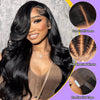French Braid VS Dutch Braid: Unraveling The Differences And Beauty
When it comes to protective hairstyles, both a French braid and a Dutch braid are popular choices among beauty enthusiasts, which can add depth and dimension to your appearance.
You may have heard of these two protective hairstyles before, but you don’t know the exact differences between them.
The following blog will explain the differences between a French braid and a Dutch braid in detail, which can help you better distinguish them.
What’s more, you will learn how to do a French braid and a Dutch braid step by step, allowing you to restyle the hair according to your demands and preferences.
1. What is a French Braid?
A French Braid refers to a kind of classic and sophisticated hairstyle, which involves weaving three strands of your natural hair together, and then gradually combining the additional parts of hair as the braids continue.
What’s more, the pieces of strands should cross over the middle one, from the crown area of your head to the nape of the neck, making the braid look like it’s cascading down the back of the head.
Generally speaking, a French braid can not only keep your hair tidy and secure but also add dimension and depth to your overall look.
There is a wide range of French braids for you to choose from, such as a single French braid on the back, two French braids on each side of the head, and so on, catering to different people’s demands and preferences.
In conclusion, a French braid is famous for its timeless elegance and polished appearance, making it a popular and wonderful choice for both formal occasions and everyday wear.
If you are looking for a hairstyle that combines chic and fashion effortlessly, a French braid is a suitable and perfect choice for you, without too much commitment of time.

2. What is a Dutch Braid?
A Dutch Braid refers to a kind of unique and textured hairstyle, which also involves weaving three strands of your natural hair together, but the two outside strands should cross under the middle one.
Therefore, a Dutch Braid can also be called an inverted or inside-out braid.
Sometimes, double Dutch braids may especially refer to “boxer-braids”.
In recent years, a French Braid has become more and more popular.
Although both a French braid and a Dutch braid involve weaving three strands, they have different braiding techniques of incorporating their strands, which have a great influence on their appearance.
To tell the truth, the braiding technique is the most essential difference between a French braid and a Dutch Braid.
As a Dutch braid plaits the two outside strands under the middle one, it looks like a single braid sitting on the top of the hair with the cascading effect, having a more textured and pronounced appearance than a French braid.
Just like French Braids, there is also a wide range of Dutch braids for you to choose from, such as a single Dutch braid on the back, two Dutch braids on either side, and so on, allowing you to restyle the hair based on your demands and preferences.
In conclusion, if you are looking for a textured and eye-catching appearance, a Dutch braid is a suitable choice for you.

3. What are the differences between a French braid and a Dutch braid?
When talking about the differences between a French braid and a Dutch braid, the essential and primary difference is the braiding technique, which leads to a series of differences between them.
The following part will explain the differences between them from four main aspects in detail, making a systematic and comprehensive comparison for you.
(1)Braiding technique.
First and foremost, the primary and essential difference between a French braid and a Dutch braid is the braiding technique.
A French braid plaits the two outside strands over the middle one, while a Dutch braid plaits two outside strands under the middle one.
(2)Appearance.
Secondly, the appearance of a French braid and a Dutch braid is also different.
Just as it has been mentioned before, a French braid can provide a timeless, elegant, and polished appearance for you.
A Dutch braid can provide a textured, eye-catching, and pronounced appearance for you.
(3)Texture.
As a French braid can keep your hair tidy and secure, it tends to be neat and sleek.
Compared to a French braid, a Dutch braid has a more voluminous and intricate texture.
That is to say, a Dutch braid is more textured and voluminous than a French braid.
(4)Occasions.
Last but not least, a French braid is suitable for both formal occasions and everyday wear, while a Dutch braid is more suitable for casual occasions.
4. How to do a French Braid?
Firstly, you should prepare the following things: a comb, bobby pins, and mini elastic rubber bands.
(1)Step 1: Brush your hair.
First of all, you should brush your hair in order to remove any tangles or knots.
(2)Step 2: Section your hair.
Secondly, select a small section of hair around the crown area of your hair, and then divide it into three even strands.
(3)Step 3: Cross over to braid.
Cross the left strand over the middle one, and then cross the right strand in the same way.
Of course, you can cross the right strand first, and then cross the left strand.
(4)Step 4: Pick up new hair.
Fourthly, pick up a new small strand on the left side, and add it to the left section.
Next, you can cross the new left section over the middle one, and repeat these procedures on the right side.
(5)Step 5: Continue to braid.
Continue to braid by repeating these procedures, adding hair from both sides of your head.
When the hair reaches the nape of your neck, you should continue to braid the hair in the way of a regular three-strand braid.
(6)Step 6: Secure the hair.
Last but not least, you should secure the end of the hair with a rubber band.
(source: Svetlana Uryanskaya)
5. How to do a Dutch Braid?
(1)Step 1: Brush your hair.
First of all, you should brush your hair in order to remove any tangles or knots.
(2)Step 2: Section your hair.
Secondly, select a small section of hair around the crown area of your hair, and then divide it into three even strands.
(3)Step 3: Cross under to braid.
Cross the left strand under the middle one, and then cross the right strand in the same way.
Of course, you can cross the right strand first, and then cross the left strand.
(4)Step 4: Pick up new hair.
Fourthly, pick up a new small strand on the left side, and add it to the left section.
Next, you can cross the new left section under the middle one, and repeat these procedures on the right side.
(5)Step 5: Continue to braid.
Continue to braid by repeating these procedures, adding hair from both sides of your head.
When the hair reaches the nape of your neck, you should continue to braid the hair in the way of a regular three-strand braid.
(6)Step 6: Secure the hair.
Last but not least, you should secure the end of the hair with a rubber band.
(source: Lainey Ostrom)
Conclusion:
After reading this blog, you must have a more comprehensive and systematic understanding of a French braid and a Dutch braid, which can help you better distinguish them.
With the step-by-step procedures, you can choose either a French braid or a Dutch braid effortlessly, meeting your personal demands and individual preferences.
It’s my pleasure if this blog can really address your concerns and problems about a French braid and a Dutch braid.
If you have any questions about human hair wigs, please feel free to leave a comment, and I will respond to you as soon as possible.
FAQs:
(1)Is it easier to do a French braid or a Dutch braid?
To tell the truth, a French braid is easier than a Dutch braid, for a Dutch braid requires more tricks.
If you don’t have enough time and energy, maybe a French braid is a more suitable choice for you.
(2)Is a French braid or a Dutch braid more protective?
Generally speaking, a French braid is more protective than a Dutch braid, because of its neat and intact structure.
What’s more, there is no volume in a French braid, preventing any tension or damage to the hair.
(3)What is the difference between a French braid and a regular braid?
The starting points of a French braid and a regular braid are different, making a great influence on their appearance.
A French braid starts from the crown area of the head to the nape of the neck, while a regular braid starts from the nape and ends with the hair length.


















































Leave a comment